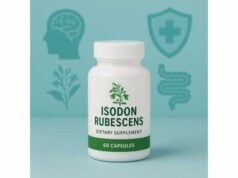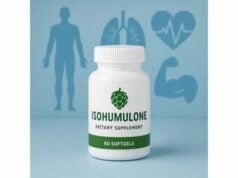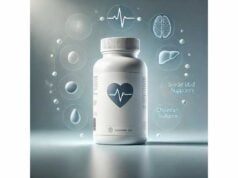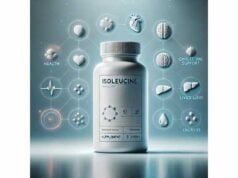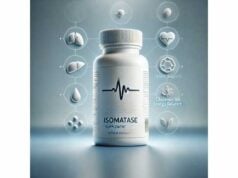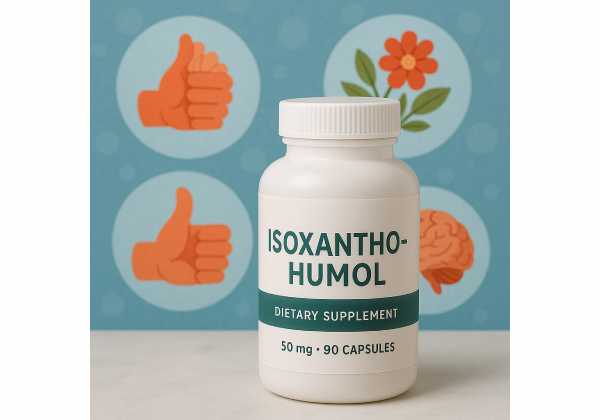
Isoxanthohumol (IX) is a prenylated flavanone found naturally in hops and, in small amounts, in beer. It has drawn attention for metabolic, liver, and gut–microbiome effects, and because some people can convert it in the body into 8-prenylnaringenin, a potent phytoestrogen. Early evidence suggests IX may support healthier blood lipids, help blunt fat absorption in the gut, and influence glucose metabolism—though most data so far come from animals and small human studies with related hop compounds. This guide translates the science into practical, people-first advice: what IX is, how it works, who it might help, how to take it safely, and where its limitations lie. You will also find clear dosage ranges, interactions, and quality pointers to use if you are evaluating hop-derived supplements. Throughout, we keep the focus on realistic outcomes, safety, and evidence you can actually use.
Quick Overview
- May support liver fat metabolism and healthier triglycerides and cholesterol in preliminary studies (animal and early mechanistic human data).
- Could reduce intestinal fat absorption and modestly improve glucose control; microbiome context matters.
- Typical supplemental range: 30–100 mg/day of isoxanthohumol from standardized hop extracts, taken with food.
- Avoid if pregnant, breastfeeding, or with hormone-sensitive conditions or active liver disease unless a clinician approves.
- Safety caveat: some individuals convert IX to 8-prenylnaringenin (a strong phytoestrogen), which may interact with hormones or medications.
Table of Contents
- What is isoxanthohumol and how does it work?
- What benefits are most plausible right now?
- How to take isoxanthohumol: forms, timing, and stacking
- Why bioavailability and your gut microbiome change the effects
- Risks, side effects, and who should avoid it
- Isoxanthohumol vs xanthohumol vs 8-prenylnaringenin: how they differ
What is isoxanthohumol and how does it work?
Isoxanthohumol (often abbreviated IX or IXN) is one of the main prenylflavonoids in hops (Humulus lupulus). “Prenylated” means the molecule carries a lipophilic prenyl group—a small structural add-on that makes it more fat-soluble and capable of interacting with cell membranes. That prenyl group helps IX lodge in tissues such as the liver and can shift how it is metabolized. In the human diet, the largest natural exposure comes from beer, where IX appears in microgram-per-liter quantities. Supplements use concentrated hop extracts to reach physiologically relevant doses.
Mechanistically, IX is best described as a pleiotropic compound: it touches several pathways at once rather than acting like a single-purpose drug. In preclinical work, IX has been shown to influence lipid metabolism in the liver (for example, signaling nodes like AMPK and PPAR-α), oxidative stress responses, and aspects of intestinal fat handling. In animal and cell studies, IX can nudge the balance away from fat synthesis and toward fat utilization, and it appears to dampen oxidative stress that exacerbates fatty liver biology. A second, practical mechanism is purely physical: IX’s presence in the gut can reduce dietary fat absorption, which then indirectly improves insulin sensitivity and lipid profiles in animal models.
A unique wrinkle is conversion. In some people, gut microbes and liver enzymes can convert IX into 8-prenylnaringenin (8-PN), an unusually strong phytoestrogen. Not everyone makes that conversion efficiently; estimates vary, but only a subset of individuals convert IX to meaningful amounts of 8-PN. This inter-individual variability helps explain why some people report estrogen-related effects from hop products while others do not. It also means the same nominal dose of IX can behave differently across people depending on their microbiome and metabolism.
Finally, IX is not the only hop prenylflavonoid you will see. Xanthohumol (XN), a precursor chalcone, co-occurs in hops and is commonly studied; your body and the gut microbiota can interconvert XN and IX under certain conditions. Many supplements contain a spectrum of these related molecules. Understanding their differences—especially IX versus XN versus 8-PN—helps set appropriate expectations, which we’ll cover in a dedicated section below.
What benefits are most plausible right now?
When evaluating botanical compounds, focus on three questions: (1) Is there a biologically plausible mechanism? (2) Do the preclinical data consistently point in the same direction? (3) Do early human data (or closely related compounds) show signals that justify careful use? For isoxanthohumol, the most plausible near-term benefits cluster around liver fat metabolism, intestinal fat handling, and downstream effects on glucose and lipids.
1) Liver fat and blood lipids. In animal models of hyperlipidemia and diet-induced fatty liver, IX has repeatedly improved hepatic fat accumulation, reduced oxidative stress markers, and shifted lipid-regulating pathways toward healthier profiles. Mechanistically, IX has been observed to influence AMPK (a cellular energy sensor), PPAR-α (which promotes fat burning), and PI3K/AKT (metabolic signaling). These shifts map to practical outcomes in models: lower triglycerides, improved cholesterol measures, and less fat stuck in the liver. This aligns with how clinicians think about metabolic dysfunction-associated steatotic liver disease (MASLD): small changes that reduce fat synthesis or enhance oxidation can compound over months to improve liver enzymes and ultrasound findings.
2) Intestinal fat absorption and glucose control. One consistent signal in preclinical work is that IX reduces intestinal lipid absorption. In mice, that reduction comes with improved body weight trajectory, lower fasting glucose, and better insulin sensitivity—especially when the gut microbiome favors certain beneficial taxa. Practically, if a compound blocks some dietary fat uptake, it can lead to modest calorie loss and less chylomicron traffic, which secondarily helps triglycerides. Early human data with related hop prenylflavonoids (notably xanthohumol) have shown tolerability and enterotype-dependent microbiome effects. While direct, large IX trials in humans are still limited, these converging lines suggest a reasonable chance of small-to-moderate benefits in metabolic markers for select users.
3) Antioxidant and anti-inflammatory context. Prenylflavonoids are capable antioxidants in vitro, but in humans, direct antioxidant activity is less important than the signaling they induce—e.g., nudging Nrf2 or dampening NF-κB–related inflammatory tone. In metabolic disease, lower oxidative stress in the liver and gut correlates with better insulin action and lipid handling. IX’s ability to localize to the liver enhances the relevance of these signaling effects.
4) Microbiome-mediated actions. A meaningful slice of IX’s action likely routes through the gut microbiome. In a subset of people, IX is converted to 8-PN, which can engage estrogen receptors. Estrogen signaling is entwined with lipid metabolism, bile acid biology, and even energy expenditure. Separately, hop prenylflavonoids can alter microbial metabolite production (e.g., bile acid derivatives), which may feed back on host metabolism.
What this means for you. If your goals include improving triglycerides, supporting a fatty-liver reversal plan alongside diet and physical activity, or seeking modest help with post-meal lipid handling, IX is a candidate worth discussing with a clinician. Expectations should be modest: think incremental changes over 8–12 weeks, not rapid transformations. People whose microbiome does not convert IX to 8-PN may still benefit through fat-absorption effects and hepatic signaling; converters may notice additional hormone-linked effects, for better or worse.
Where evidence is weak. Claims around mood, sleep, or broad anti-cancer effects are not yet supported in humans. Likewise, IX should not be used as a sole therapy for diabetes, dyslipidemia, or fatty liver disease; it is an adjunct to nutrition and movement, not a replacement.
How to take isoxanthohumol: forms, timing, and stacking
Forms you’ll see.
- Standardized hop extracts listing isoxanthohumol (mg per serving). Some also list xanthohumol and 8-prenylnaringenin.
- Mixed prenylflavonoid complexes from hops (often marketed for “metabolic” or “menopausal” support).
- Beer is a natural source, but levels are far too low (micrograms per liter) to serve as a meaningful or safe delivery method; alcohol introduces health risks and calories.
Evidence-aligned dose range.
- Typical supplemental range: 30–100 mg/day of isoxanthohumol from a standardized hop extract.
- Why this range? It is high enough to mimic tissue exposures relevant in preclinical models when scaled for humans, yet remains within amounts commonly found in commercially available formulations. Because individual conversion to 8-PN varies, start near the lower end if you’re sensitive to estrogenic effects.
- Titration: Increase by 25–50 mg every 2–4 weeks while monitoring for benefits (lipids, fasting glucose) and any side effects (see safety).
- Timing: Take with a meal containing fat to improve absorption; prenylflavonoids are fat-soluble.
- Cycling: For users concerned about phytoestrogen exposure, a 12-weeks-on / 4-weeks-off cycle is reasonable while tracking labs and symptoms.
Duration before reassessment.
- Plan 8–12 weeks before judging impact on fasting triglycerides, ALT/AST (liver enzymes), non-HDL cholesterol, or waist circumference. Re-test labs to avoid guesswork.
Stacking ideas (practical and conservative).
- With fiber or meal-bound fat modulators (e.g., psyllium): complements IX’s intestinal fat-absorption effects.
- With exercise and protein: improvements in insulin sensitivity amplify lipid-handling benefits.
- Avoid stacking with strong phytoestrogen formulas (e.g., high-dose 8-PN) unless that is your intent, as estrogenic load can add up.
- Medication timing: Space IX away from binding-sensitive medications (e.g., bile acid sequestrants) by at least 3–4 hours.
Quality checklist when buying.
- Label clarity: specific milligrams of isoxanthohumol, not just “hops extract.”
- Standardization: batch-tested for IX (and disclosure of 8-PN content if present).
- Certificate of Analysis (CoA): third-party tested for identity, potency, heavy metals, and microbial contaminants.
- Formulation: oil-based softgels or inclusion complexes can enhance absorption; powders can work when taken with fat.
- Transparency: brands that disclose the spectrum of hop prenylflavonoids help you anticipate estrogenic effects.
Special cases.
- Menopausal symptom use: IX itself is a weak phytoestrogen; if relief is the goal, some products rely on 8-PN rather than IX. Discuss with a clinician, particularly if you have a history of hormone-sensitive conditions.
- Athletes cutting weight: mild reductions in fat absorption could help, but monitor energy availability and fat-soluble vitamin status over time.
Why bioavailability and your gut microbiome change the effects
Two people can take the same IX dose and experience different outcomes. The reasons are straightforward but important:
1) Tissue distribution and metabolism. After ingestion with food, IX is absorbed and distributed, with a notable affinity for the liver, where lipid metabolism is coordinated. Animal pharmacokinetic work shows rapid appearance in plasma and meaningful liver concentrations. Over days to weeks, IX and its conjugates appear in several tissues. This matters because a compound that reaches the liver can directly influence fat synthesis, oxidation, and export rather than acting only in the gut lumen.
2) Conjugation and deconjugation. Like many polyphenols, IX is often glucuronidated or sulfated (attached to a sugar or sulfate) in the intestine and liver. These conjugates circulate and can be deconjugated locally, creating site-specific pools of active aglycone. That on/off switching contributes to variable potency and duration.
3) Microbiome conversion to 8-prenylnaringenin. A subset of people harbor gut microbes (e.g., strains in the Eubacterium genus) that can convert IX to 8-PN, a strong phytoestrogen capable of binding estrogen receptors. This conversion depends on O-demethylation steps that not every microbiome can perform. Observationally, only a portion of individuals produce appreciable 8-PN after consuming hops.
- Implication: If you are a “converter,” you may feel estrogen-linked effects (breast tenderness, cycle changes), and you might experience different metabolic outcomes. If you are a “non-converter,” IX may act more through fat-absorption and hepatic signaling pathways with fewer estrogen-like effects.
- Practical tip: If you’re curious whether you convert, track symptoms and, ideally, use pre-/post-supplement hormone panels with a clinician. Some research settings measure urinary 8-PN metabolites, but that is not common in routine practice.
4) Enterotypes and bile acids. Human trials with hop prenylflavonoids suggest enterotype-dependent responses—microbiome community types (e.g., Prevotella- or Ruminococcus-dominant) that process compounds differently. Because bile acids regulate fat absorption and metabolic signaling (FXR, TGR5), even small shifts in microbial bile acid metabolism can change how IX “lands” in your physiology.
How to tilt the odds in your favor.
- Take with fat. A mixed meal with 10–20 g of fat is a simple way to raise IX absorption.
- Feed your microbiome well. A diet richer in soluble fiber (oats, legumes), polyphenols (berries, olive oil), and fermented foods supports microbial diversity that tends to produce steadier metabolic responses.
- Monitor, don’t guess. If your goal is lipid support, track fasting triglycerides, non-HDL cholesterol, ALT/AST, and waist at baseline and every 8–12 weeks. If estrogenic effects are a concern, log cycle symptoms.
Risks, side effects, and who should avoid it
Common tolerability. Across supplements containing hop prenylflavonoids, the most frequent complaints are mild and gastrointestinal: nausea, bloating, or looser stools, especially at higher doses or when taken without food. Because IX can reduce fat absorption in the small intestine, some users notice more frequent stools after high-fat meals. These effects usually ease with dose adjustment, dividing doses, or adding fiber at mealtime.
Hormone-related effects. The headline caution is conversion to 8-prenylnaringenin. While IX itself is only weakly estrogenic, 8-PN is potent. If your microbiome converts IX efficiently, you could experience breast tenderness, cycle irregularity, or hot-flash changes. In men, high phytoestrogen exposure has occasionally been linked to decreased libido or gynecomastia-like symptoms in case reports with other botanicals; these remain uncommon but deserve attention.
Liver considerations. IX concentrates in the liver and aims to help lipid handling, but that does not give a free pass. If you have active hepatitis, cirrhosis, or unexplained elevated liver enzymes, involve your hepatology or primary care team before starting. Importantly, beer is not a therapeutic delivery route for IX—alcohol worsens liver disease.
Interactions and timing.
- Hormone therapies: Exercise caution if you use estrogen/progestin therapies (HRT or combined oral contraceptives). Discuss benefits and risks with your clinician; phytoestrogens may theoretically modulate effects.
- Anticoagulants/antiplatelets: Hop constituents can have mild antiplatelet effects in vitro; clinically meaningful interactions are rare, but if you’re on warfarin or direct oral anticoagulants, keep your prescriber in the loop and monitor as advised.
- Drugs affected by fat absorption: If you take bile acid sequestrants, orlistat, or lipophilic medications that need consistent absorption, separate dosing by 3–4 hours.
- Pregnancy and lactation: Avoid due to insufficient safety data and the potential for estrogenic activity.
Who should avoid IX (unless medically supervised).
- Pregnant or breastfeeding individuals.
- People with hormone-sensitive cancers (e.g., estrogen receptor–positive breast cancer) or endometriosis.
- Active liver disease without clinician oversight.
- Adolescents (lack of safety data during development).
How to use IX safely.
- Start low (e.g., 30 mg/day) with food and reassess after 2–4 weeks.
- Track biomarkers if using IX for metabolic goals; it is the simplest way to know if you are a responder.
- Pause and reassess if you notice hormonal side effects or if liver enzymes rise on routine labs.
- Don’t mix with alcohol as a “delivery method.” If you drink, do so within standard low-risk guidelines and separately from supplement use.
Isoxanthohumol vs xanthohumol vs 8-prenylnaringenin: how they differ
Family overview. Hops provide a small family of prenylflavonoids that interconvert in the body and in the gut:
- Xanthohumol (XN): A prenylated chalcone. It is the major hop prenylflavonoid by weight in raw hops and is widely studied for metabolic and antioxidant signaling. In humans, it shows good tolerability at supplemental doses and can convert to IX under certain conditions.
- Isoxanthohumol (IX): A prenylated flavanone, formed from XN through cyclization. It is less abundant in raw hops than XN but can be the dominant prenylflavonoid in beer. IX is the focus of this guide; it acts on hepatic lipid signaling and intestinal fat handling and can convert to 8-PN.
- 8-Prenylnaringenin (8-PN): A prenylated flavanone and one of the most potent phytoestrogens known. It can be present in small amounts in hops and beer, but most human exposure comes from microbiome-mediated conversion of IX and, to a lesser extent, XN. Because 8-PN binds estrogen receptors strongly, products standardized to 8-PN are often marketed for menopausal symptom support rather than metabolic health.
Potency and targets.
- On estrogen receptors, 8-PN ≫ IX ≈ XN (8-PN is the outlier for estrogenic potency).
- For metabolic signaling, all three can influence liver and adipose biology, but IX and XN are more often discussed in the context of lipid handling and oxidative stress; 8-PN’s benefits and risks run through estrogen pathways.
Pharmacokinetics in brief.
- XN is the best-studied in humans, with trials showing linear pharmacokinetics and substantial inter-individual variability in metabolite profiles.
- IX concentrates in the liver in animal models, with detectable levels in multiple tissues and measurable conversion to 8-PN over time.
- 8-PN appears in circulation mainly in converters; its glucuronides and sulfates can be hydrolyzed in tissues, providing localized activity.
Which is right for which goal?
- Metabolic/liver support: IX or XN are more aligned choices. IX may offer a practical advantage for liver targeting and intestinal fat effects.
- Menopausal symptoms: 8-PN–standardized products are the direct approach, but they carry estrogenic caveats. Some people prefer to start with IX and see if conversion provides sufficient benefit; others avoid estrogenic pathways entirely.
Supplement label realities. Many “hop extracts” contain a spectrum of these molecules. Read labels carefully and—ideally—choose products that disclose the actual milligrams of each key prenylflavonoid. If you specifically want IX without much 8-PN, look for low 8-PN content and consider starting with lower doses while you evaluate your response.
Bottom line. IX sits in the metabolic sweet spot of this family: weaker on estrogenicity than 8-PN yet strong enough on lipid and liver signaling to matter—especially when combined with diet, movement, and weight-management strategies.
References
- Tissue distribution and pharmacokinetics of isoxanthohumol from hops in rodents (2023)
- Isoxanthohumol improves obesity and glucose metabolism via inhibiting intestinal lipid absorption with a bloom of Akkermansia muciniphila in mice (2023)
- Isoxanthohumol improves hepatic lipid metabolism via regulating the AMPK/PPARα and PI3K/AKT signaling pathways in hyperlipidemic mice (2024)
- The Potent Phytoestrogen 8-Prenylnaringenin: A Friend or a Foe? (2022)
- The prenylflavonoid isoxanthohumol from hops (Humulus lupulus L.) is activated into the potent phytoestrogen 8-prenylnaringenin in vitro and in the human intestine (2006)
Disclaimer
This article is for educational purposes only and is not a substitute for personalized medical advice, diagnosis, or treatment. Isoxanthohumol may interact with medicines and health conditions, and effects can vary widely among individuals. Always speak with your licensed healthcare professional before starting any new supplement, especially if you are pregnant, breastfeeding, have hormone-sensitive conditions, or have liver disease. If you choose to use isoxanthohumol, monitor your health and laboratory values regularly with your clinician.
If you found this guide helpful, consider sharing it on Facebook, X (formerly Twitter), or your preferred platform, and follow us for more evidence-based, people-first health content. Your support helps us continue producing high-quality resources.

